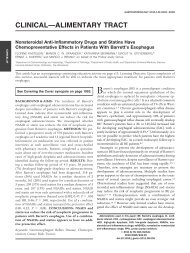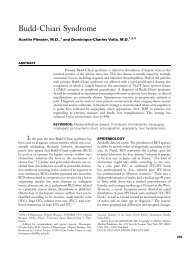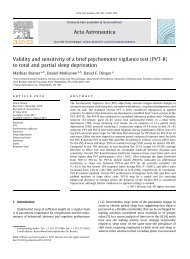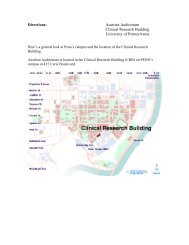PPP_Summer 2010_EDITED FINAL 072010:PPP.qxd - University of ...
PPP_Summer 2010_EDITED FINAL 072010:PPP.qxd - University of ...
PPP_Summer 2010_EDITED FINAL 072010:PPP.qxd - University of ...
You also want an ePaper? Increase the reach of your titles
YUMPU automatically turns print PDFs into web optimized ePapers that Google loves.
PAGE 2<br />
Chairman’s Report<br />
Barely noticed in October 2008, amid the clamor <strong>of</strong> the Presidential<br />
campaign and a nationwide financial crisis, Congress<br />
passed and President Bush signed the Paul Wellstone and<br />
Pete Domenici Mental Health Parity and Addiction Equity Act<br />
(MHPAEA) (P.L. 110-343), legislation long awaited by the mental<br />
health community.<br />
The law was quietly tucked into the $700 billion Emergency<br />
Economic Stabilization Act <strong>of</strong> 2008 in Division C, Title V, Subtitle<br />
B, Section 511, just a small corner <strong>of</strong> the legislation which<br />
created TARP, the “bailout” package for the nation’s financial<br />
system. However, for those <strong>of</strong> us centrally concerned about the<br />
quarter <strong>of</strong> America’s adult population who experience mental<br />
illness each year, or the almost half who suffer from these disorders<br />
during a lifetime, it is a major achievement.<br />
For almost four decades, mental health advocates have fought<br />
to ensure that mental health benefits in health insurance plans<br />
are equivalent to medical and surgical benefits. This has not<br />
been an easy road for many reasons. The public and many medical<br />
pr<strong>of</strong>essionals have questioned the biological and medical<br />
origins <strong>of</strong> mental health disorders. Following this lead, health<br />
insurance companies have <strong>of</strong>ten failed to cover mental health<br />
disorders in their plans or, when they did, they did not <strong>of</strong>fer<br />
benefits equal to their medical and surgical benefits. In addition,<br />
according to the Congressional Research Service (CRS),<br />
insurers were reluctant to provide parity coverage because they<br />
believed that “mental disorders are difficult to diagnose, and<br />
that mental health care is expensive and <strong>of</strong>ten ineffective.” 1<br />
Scientific evidence showing the linkage between the brain and<br />
biology, new effective therapies, the untiring work <strong>of</strong> advocates<br />
for the mentally ill, and, quite frankly, the personal and family<br />
experiences <strong>of</strong> key legislators who had to face up close the<br />
crushing impact <strong>of</strong> mental health and substance abuse disorders<br />
spurred legislative efforts to address this imbalance.<br />
In the 1970s, individual states began to attack the insurance<br />
inequity problem. They were joined at the federal level in 1996<br />
with the passage <strong>of</strong> the Mental Health Parity Act (MHPA). This<br />
law prohibited annual and lifetime dollar limits on mental<br />
health coverage which were more restrictive than those<br />
imposed on medical and surgical coverage. This was a good<br />
first step, but there were many more facets to the parity imbalance<br />
left for the 2008 act.<br />
Among many positive changes, 2 the new MHPAEA expands the<br />
definition <strong>of</strong> mental health to include substance abuse disorders.<br />
Significantly, as detailed in the Interim Final Rule (IFR)<br />
regulations scheduled for implementation on July 1, <strong>2010</strong>, it<br />
increases substantially the number <strong>of</strong> benefit requirements in<br />
health plans that must be made equivalent for medical, surgical,<br />
and mental health disorders. These stipulations include those<br />
governing annual and lifetime coverage limits, deductibles, copayments,<br />
out-<strong>of</strong>-pocket limits, out-<strong>of</strong>-network coverage, covered<br />
inpatient days and outpatient visits, and managed care<br />
practices such as prior authorization and utilization review.<br />
Importantly, too, the new law allows state laws which provide<br />
stronger parity provisions than the federal legislation to remain<br />
in effect.<br />
PENN PSYCHIATRY PERSPECTIVE � SUMMER <strong>2010</strong><br />
The MHPAEA is a landmark<br />
law. The National Alliance on<br />
Mental Illness (NAMI) stated,<br />
“mental illness treatment [is] no<br />
longer being subject to 2nd class<br />
status in our health care system.”<br />
But NAMI, the American Psychiatric<br />
Association, and other mental<br />
health advocates well know<br />
that final victory has not been<br />
achieved.<br />
The MHPAEA applies to group<br />
health plans for employers with<br />
51 or more employees, Medicaid<br />
managed care plans, the State<br />
Children’s Health Insurance Program (SCHIP), non-federal governmental<br />
plans, and federal employees health benefits plans,<br />
potentially about 150 million people in all. However, it does not<br />
apply to plans <strong>of</strong> small companies, individual plans, and<br />
Medicare. The law allows insurers to determine which mental<br />
illnesses they will cover. Also, determining parity <strong>of</strong> treatments,<br />
such as the use <strong>of</strong> psychotherapy which has no exact equivalent<br />
for non-mental health diseases, may prove problematic. And,<br />
critically, the new law does not require that plans provide benefits<br />
for mental health and substance use disorders, only that<br />
these benefits be on par with medical and surgical benefits if<br />
the plan covers them. Moreover, the proposed implementation<br />
regulations, which are favorable for parity, are being challenged<br />
by insurance companies and employer groups who object to the<br />
rules specifying a single integrated deductible for mental<br />
health, medical, and surgical diseases and to selected provisions<br />
guiding how insurers manage mental health benefits.<br />
Nonetheless, the MHPAEA <strong>of</strong> 2008 is a big step to guaranteeing<br />
that insurance coverage for mental health disorders is on par<br />
with coverage for medical and surgical illnesses. Here, in the<br />
Department, we will continue to monitor the implementation <strong>of</strong><br />
the MHPAEA to make sure that it meets the needs <strong>of</strong> those who<br />
need care for mental health and substance abuse disorders, and<br />
we will press for further change as needed.<br />
Dwight L. Evans, MD<br />
Ruth Meltzer Pr<strong>of</strong>essor and Chair<br />
Pr<strong>of</strong>essor <strong>of</strong> Psychiatry, Medicine and Neuroscience<br />
1<br />
CRS Report for Congress, “Mental Health Parity: Federal and State Action and Economic<br />
Impact,” updated June 19, 2008.<br />
2<br />
CRS Report for Congress, “Mental Health Parity: An Overview,” updated November 19,<br />
2008; CRS Summary, “H.R. 1424: Emergency Economic Stabilization Act <strong>of</strong> 2008;” NAMI<br />
Fact Sheet: Federal Parity for Mental Illness and Addictions;” American Psychiatric Association,<br />
“APA Reacts to the Mental Health Parity Regulations.”<br />
To view recent Chairman Reports on-line, please visit:<br />
http://www.med.upenn.edu/psych/chair.html<br />
www.med.upenn.edu/psych
















